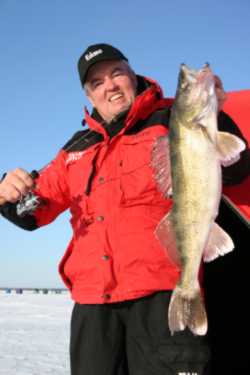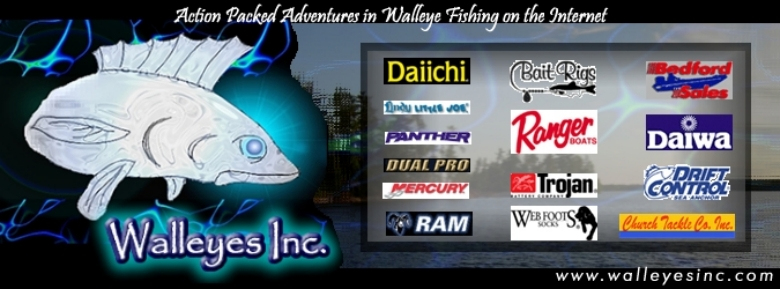| There’s a lot of talk about just how good
first walleye angling can be and that maybe so, but what follows
can be every bit as good. In fact there's some really hot action
left for those that stay with it and are willing to make the
moves necessary to catch up with a fish that can't seem to stay
in one place for very long. Mid season walleyes aren’t
all that tough to find and are usually still plenty active and
that plays right in to the hand of those willing to stay the
course.
They’re not that hard to find because they typically
set up on deeper hard bottom breaks
and drop offs, a.k.a. structure. Structure can come in many
forms and includes deeper
points, humps, break lines, etc. Taking a look at a good
map will get you quickly pointed
in the right direction and save can you a lot of time and
effort. Look for deeper structure
nearest the deepest portion of the lake, and then look for
anything that can help
concentrate fish.
 Ron
Anlauf worked his plan for this huge Ron
Anlauf worked his plan for this huge
Walleye
|
A good depth finder will help make the job
of finding a breakline much easier and can even help you
find fish. Early in the season you can usually shoot right
through the ice (as long as it isn’t roughed up
or busted up) and see bottom reading as well as anything
holding off, like fish. What you need is a flat smooth
surface and a little water to make a seal around the face
of the transducer to get a reading and why I carry a self
lighting torch. The torch melts enough ice in seconds
and can even smooth out the surface, to a certain extent.
When it comes to depth finders I’ve basically used
them all and prefer the flasher types and this year I’ll
be using the new Ice Flasher Series from Humminbird. These
high tech units utilize fiber optics to produce an incredible
super sized display that is easily read, even in direct
sunlight. They also have dual cone width transducers which
allow you to take in more, or eliminate unwanted interference
(like your neighbor’s bait). The Ice 45 and 55 models
even have a digital readout that leaves nothing to question
when it comes to exact depth. |
With the depth finder you can start to get an idea of a
how an area is laid and can begin trying to uncover some of
the concentration points. High concentration spots can include
little points, inside turns, and areas that break more quickly
than others. What you’re looking for is something a
little different than the rest, as those are the spots that
fish tend to load up on. You can also separate the different
areas by when they should be expected to produce and key on
the best spots for that specific time of the day. It really
isn’t all that complicated, it’s just that you
may want to move deeper during the day and shallower at sunup
and sundown. If you happen to be fishing shallow when you
should be deep (or deep when you should be shallow), you might
miss the whole thing.
Good daytime spots include the deepest edge of a break or
the base of a deep hump
where the break starts to flatten out. Good morning and evening
spots include the top
edge of the break and right into the middle of a hump or
bar. The aforementioned is
nothing more than a rule of thumb and there’s always
exceptions but that info can help you get pointed in the right
direction. It would also be best to narrow your search down
to two or three key areas, as there just isn’t enough
time in the day to effectively cover much more.
The fact is you can’t be in two places at one time,
or can you? You can if you trade in
one of your rods for a tip-up, and let it do what it’s
going to do. Tip-ups can provide
some range and allow you to divide your attention between
potential fish holding areas.
A good plan of action would include working a jigging spoon
on the most likely looking
spots for that time of the day, and placing a tip-up where
they might be. It’s a great way
to keep the fish honest, just in case they’ve thrown
you a curve. Another plus to using a tip-up is the fact that
a tripped flag can really get the adrenaline going. First
off there’s a mad dash to get to it, followed by gingerly
picking up the line to see if anybody’s home, and finally
setting the hook on those left holding the bait. It’s
also a way to vary your presentation as you never know for
sure what old marble eyes is looking for. There will be times
when they’re only interested in something jumping like
crazy, and a bait sitting dead still at others. The combination
of a two prong approach will help you nail it down.
A key to successful tip-up angling is getting the bait set
at the right depth, and usually
demands that you be within a foot or so of the bottom. To
help with the set up try
using a slip bobber knot to mark the surface after lowering
a clip-on depth finder to the
bottom. From there you’ll know how much line to reel
up onto the tip-up to keep the
bait in the “zone”.
After you get a tip-up set on a likely spot it's time to
get to work on the other part of the
plan and where a jigging spoon really comes into play. A
spoon in the right hands be can extremely effective and there
is no reason why your hands can't be the right ones. It just
takes a stick to it attitude and not giving up if you don't
immediately succeed.
One of the hottest lures on ice has been the Northland Buck
Shot Rattle Spoon. There's a few reasons why it's been so
hot including size, color, and the racket a rattle can make.
The Buck Shot Rattle Spoon comes in sizes from 1/16 to 3/4oz
which means you can find one that’s not too big, not
too small, but just right for ol' marble eyes. It's also available
in some great colors including several glow patterns. The
rattle is another big key to the spoon's success as it can
really make a difference in the number of walleyes you're
able to put on the ice. For whatever reason rattles do work,
and if you're not rattlin' you definitely should be. See you
on the ice, with a tip-up and a spoon.
Ron Anlauf
|

